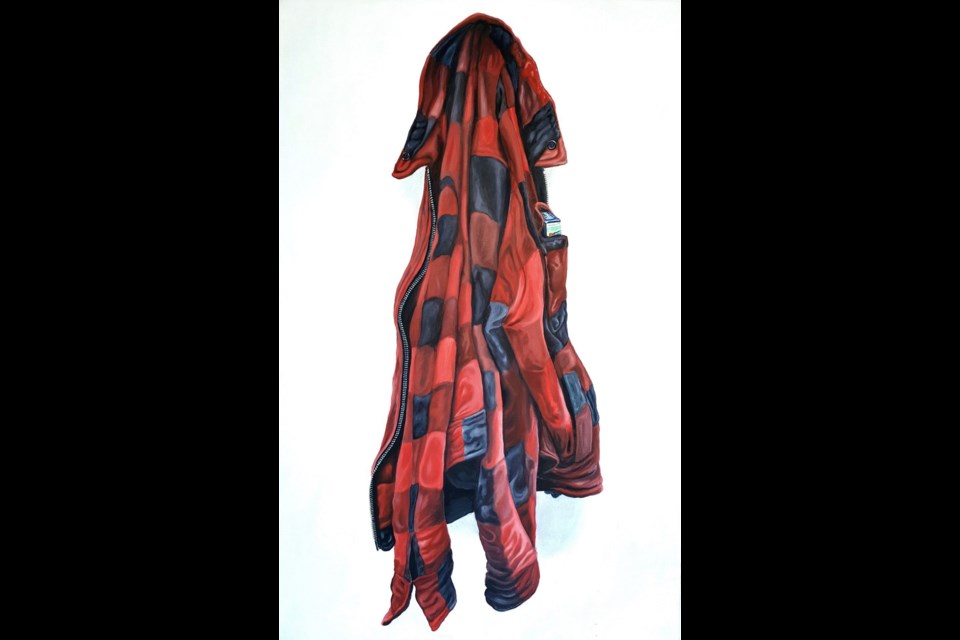 On the wall of Nick Vandergugten’s James Bay apartment hangs a painting by his father, Bert Vandergugten. It’s a night scene of revellers in Fan Tan Alley, at a Halloween party in 1983. Under the autumn moon, the alleyway is crowded, but every storefront is boarded up. That painting was created about the time of Nick’s conception.
On the wall of Nick Vandergugten’s James Bay apartment hangs a painting by his father, Bert Vandergugten. It’s a night scene of revellers in Fan Tan Alley, at a Halloween party in 1983. Under the autumn moon, the alleyway is crowded, but every storefront is boarded up. That painting was created about the time of Nick’s conception.
The youngster grew up in Chinatown, living there with his parents until the age of eight.
“Early childhood was filled with a wonderful collection of eccentric people and parties,” Vandergugten recalled: “Luis Merino, Laird Campbell, D’Arcy Gould — the famous or the infamous.” But it was really no place to raise a family, he told me. “I was sometimes running further than I was supposed to, getting into a little bit of trouble.”
The Vandergugtens moved to the far side of Thetis Lake.
“Langford had pitfalls,” he recalled, “and a well-deserved reputation as a bit rough, but I had a good mom and dad.” After high school, he spent a year in Australia, and then put in time “bumping around Canada, working in kitchens, hitchhiking and writing.” His dream was to be a writer.
Returning to Victoria eight years ago, Vandergugten was feeling a bit rootless and wanted to invest his time in something serious. At the age of 26, he again found himself living in Chinatown, in an upstairs studio on Fan Tan Alley with artist Jim Lindsay and photographer Alan Edgar as neighbours — “the same people who knew me as a kid,” he chuckled.
His studio was upstairs from Ground Zero Printmakers, and he was taken on as an apprentice. Woodcuts became his printmaking medium of choice.
“It’s a great medium for young artists,” he said. “You can sell prints for an affordable price, and your friends and family become your first patrons.” He immediately attracted notice with his expressionist image of the Johnson Street Bridge.
As it had just been announced that the bridge would be replaced, the timing was propitious.
“It was part of the telling of the story of Victoria,” he said, “part of my own personal need to investigate history.” For Vandergugten, the bridge was a symbol of his homecoming: “the hum of the tires on the grating when you went over the bridge.” It wasn’t just a prudent business move.
“It started before that,” he said. “I feel that your work needs to embody your own connection to the place. Without that personal inroad, I can’t seem to muster the time and energy.”
There was also skill involved in his early success.
“It certainly didn’t come out of nowhere.” Vandergugten said. “My father was a stay-at-home dad. He never directly taught me, but he had a studio at home, and I was always drawing at his side.” While Bert Vandergugten hasn’t exhibited his art in years, he continues to paint at his home in Langford.
About three years ago, Nick got married and, with his wife, Kate, moved to James Bay. Getting serious about his art career, he enrolled in the visual-art program at the University of Victoria, to extend into other areas of art.
“I had reached a level of competence with printmaking,” he said. “To go into painting was pretty humbling.” During the ensuing years, he explored so many options “it became almost terrifying. I went to UVic to experience the contemporary manifestations,” he said. “I knew I was really rooted in a more geographical tradition, history and lineage a bit more local. I wanted to explore how that would open out.”
A series of very large prints of hands, laminated on wooden panels, were exhibited at the 50/50 Arts Collective in 2014.
All these influences have led to the current series of highly resolved paintings of coats and jackets, which were hanging on the wall, both literally and figuratively. On a series of canvases, Vandergugten has painted emblematic clothing against a blank backdrop.
First came a reflective safety vest, painted during a period when he was in residence at the Banff Centre. Beside it hung a yellow raincoat glistening with waterdrops, and then a sleeveless leather jacket with studs and punk-rock graffiti. Vandergugten has undertaken the challenge of trompe l’oeil painting with an impressive skill.
“I hope it’s not just [the skill] that’s talking,” he said. “That was my brother’s jacket, and the Ripcordz was the name of a local punk band. It’s tremendous, being able to mythologize stuff that is so personal.” A painting of a grey Stanfield’s woollen sweater refers to the labour Vandergugten still does to support himself.
“Stanfield’s is a big staple for labourers and carpenters.”
There are wider references to the art world — he mentions Andy Dixon of Toronto. But it’s also a personal and a local story. Unintentionally, Vandergugten has painted his autobiography.
Victoria’s Tim Hoey works full-time to immortalize the folksy aspects of Canadiana, and the late Jeff Molloy had a similar fascination with local contemporary history. Referring to a painting of a red plaid jacket with a pack of smokes in the pocket, Vandergugten told me: “That could be a portrait of Jeff. He always had that jacket.”
A young artist can choose any subject, and Vandergugten has decided his life is an appropriate subject for art.
“Paint what you know,” Vandergugent said.
“Otherwise it will come across as phony. The only thing we have to add to the conversation is what you know.”



